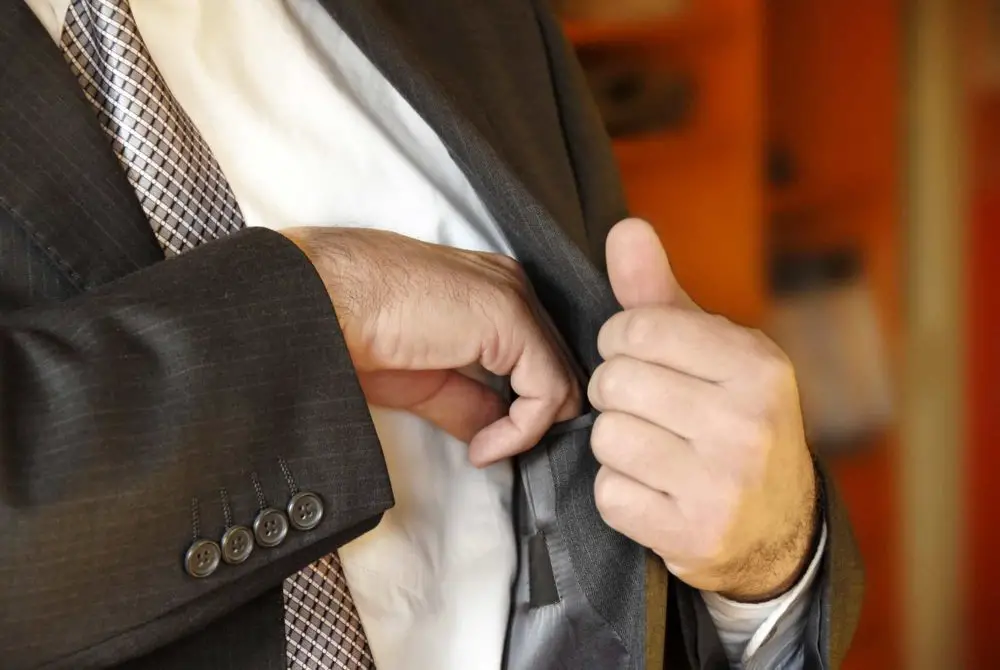Having a secret pocket is just as much fun for adults as it is for children. There is no reason, though, to pay tons of cash for a premade version. Read on and learn how to make a secret pocket in your jacket.
Table of Contents
What Is a Hidden Pocket?
A hidden pocket is one that is not visible from the outside. It’s usually sewn into the lining of a jacket and makes a great place to hide items of value. Travelers often use them to hide their wallets and passports.
Why Do You Need One?
It’s more complicated, though not impossible, for a pickpocket to access a secret inside pocket opening. They often zip shut to ensure that your valuables are more secure.
It is also a fun way to store things in your everyday life. A jacket with secret pockets can make you feel like a superspy when you pull your wallet out from seemingly nowhere.
How to Sew A Hidden Zipper Pocket in a Jacket
Choose the Location and Size
Before you learn how to sew a hidden welt pocket into a jacket, you’ll have to work out where you’ll place it. It’s useful to put it on the opposite side to that of your dominant hand. Doing so makes it easy to reach in and retrieve something.
The size will depend on what you want to store in the inside pocket. Your maximum length will be from just under the armhole to about an inch from the coat lining or ribbing at the bottom. Keep in mind that the more you store, the more obvious it will be from the outside.
Making the compartment slightly bigger than your wallet and adding about an inch and a half of seam allowance is a good starting point.
If you’re using a jacket without internal lining, make the pocket big enough to anchor on two of the existing seams. That way, you won’t have to worry about thread showing through on the other side.
Will You Use a Zipper?
In this tutorial, we’ll deal with both. If you choose to include a zipper, try positioning it horizontally and vertically to find which orientation makes more sense for you.
Your zipper should be long enough so you can easily slip your hand in and out. Allow for an inch of extra space on three sides of it as a seam allowance.
The Quick No-Zipper Version

For this version, you’ll fold your fabric in half to create a firm bottom. You’ll then stitch the two side seams together with the right sides facing before hemming the top. Turn the fabric inside out, and you’ve created the space.
Turn the top inside out and position the little pocket. Pin it into place on the seams and then test it out to see if it’s easy to use. When it’s in the correct position, stitch securely.
Creating a Zippered Version
With the zippered version, you’ll approach things slightly differently. Lay the fabric flat on the table and place your zipper about half an inch away from the top edge. Mark on either side of the raised teeth of the zipper and the edges.
Draw a rectangle that will completely enclose the zipper’s teeth, but that’s small enough to catch the zipper’s fabric. Place the zipper on the wrong side so that it opens onto the right side. Then stitch along the rectangle you drew to secure it.
Now carefully cut away the fabric inside the rectangle as close to the stitch line as possible. This cut will reveal the zipper’s face, and you’ll be able to open and close it quickly.
Fold the pocket in half, wrong sides together, and stitch the side seams down. Continue from there as we did in the non-zippered version.
Attaching the Pocket to the Coat Lining
You’ll use this method during the construction of a new jacket. It gives the neatest finish overall. Instead of attaching your fabric to the side seams, you may sew it straight into the coat lining.
You’ll create the pouch by following the methods outlined above. You’ll either stitch it onto one of the lining edges or cut a slit in the lining to accommodate it. Stitch the slit pocket to the wrong side of the lining.
You’ll need to fold down the raw seams on the right side or conceal them with bias tape to close off the garment. Topstitch along the open edges to finish them off neatly.
Zipping It Up
You now have a jacket with a hidden pouch and can decide what to conceal in there. Please be careful, though — it might be a tempting place to hide your firearm, but that might get you into trouble with the law.
Instead, stick to safer things, like your wallet, keys, and passport. Just don’t forget they are there. You’ll have concealed them so well it might take some effort to find them.

